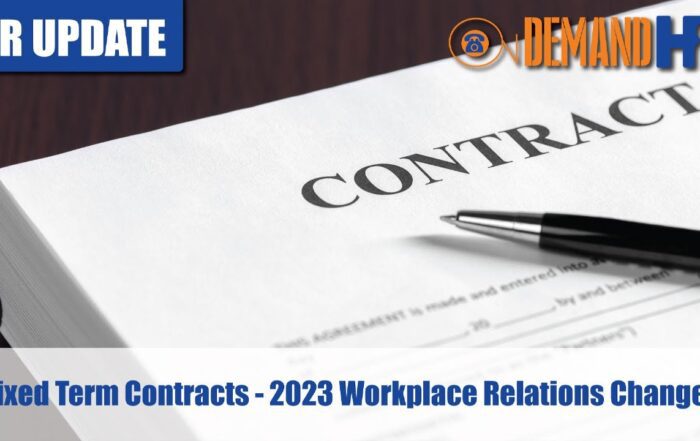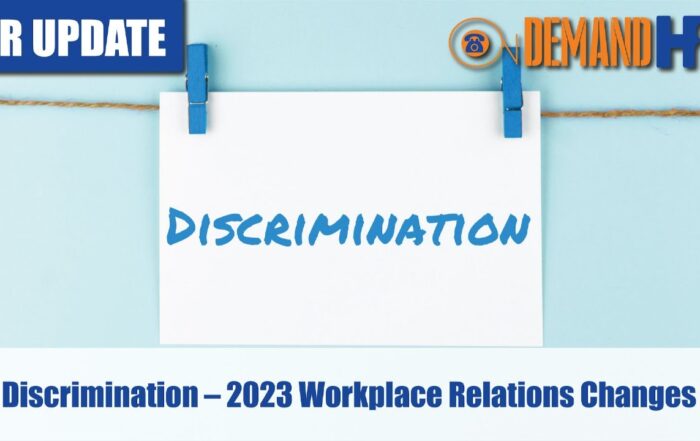3 Written Warnings – An Urban Myth?
In E1 of HR Fridays Clint will be unpacking some of your obligations when conducting a termination process including if there is a requirement to give 3 written warnings prior to termination or any at all? As always with these live sessions, bring along any of your HR / Workplace Relations questions or challenges and Clint will be happy to address them live for you
Please see below for a full transcript of the video
Share the HR or workplace relations challenge facing your business and one of our experienced consultants will be in touch within 24 hours with a strategic action plan or discover the best strategy yourself by accessing out free online training library.
Transcript
Clint Indrele 0:14
Good morning ladies and gentlemen. Welcome to HR Fridays. We thought Clint Indrele, Managing Director of On Demand HR, great for all of those who are going to be joining us today. Every Friday at 11:30. We’re going to be covering specific HR and Workplace Relations topics. I’m going to try and cover one or two topics each week. So please let us know any topics of interest for future sessions that we intend to have. Please interact with us today on the comments. Let us know your thoughts on the subject matter. Let us know any other things that might be of interest to you. This segment HR Fridays is going to be live every week on Facebook. It’s all about providing advice, which is reality.
Clint Indrele 0:56
So this is the key difference that On Demand HR offers to its clients. That we provide advice based on a real understanding of risk. From much work that we’ve done in the Fair Work Commission as a paid agent. I’ve conducted numerous workplace investigations and we’ve also operated another tribunals such as the Australian Human Rights Commission, and some and so forth. And for those also that are looking for some more information about our services, please go to www.ondemandhr.com.au there’s plenty things on that that will also assist you in respect to getting an understanding of our services and so on. Alright, so look, without further ado, we’re going to get into today’s subject so basically, as you can see there HR Friday’s live 11:30 each week, weekly tips tricks and hacks with myself Clint Inrele Managing Director of On Demand HR.
Clint Indrele 1:52
Okay, so without further ado, we’re going to get into today’s presentation. So today’s topic is going to be Three written warnings an urban myths? So we hear a lot from people who work in business that do, I have to give someone free written warnings? Oh I will need to give someone three written warnings before I carry out any further action or before I terminate. So let’s really look at the origin of this and critically analyze this particular issue.
Clint Indrele 2:21
So first of all, I guess, we have to get to get an understanding of why we give warnings in the first place. And for those who don’t understand why we give warnings have a read of Section 387 of the Fair Work Act, specifically Part E. And what this talks about is it talks about the Commission, the Fair Work Commission’s criteria, when it looks at assessing whether or not a dismissal is either fair, or unfair. And section 387E talks about that if the dismissal relates to unsatisfactory performance by the person whether the person had been warned about that unsatisfactory performance before the dismissal.
Clint Indrele 3:01
So I’m going to pick up on a couple of key words in that particular section of the Act. First of all it talks about unsatisfactory performance. So this, this is very much focused on the performance side of things more than anything else. And also, whether that person had been warned. So it doesn’t actually talk about the number of warnings. And and from that particular sentence, I make two observations.
Clint Indrele 3:27
And the first observation is that whether a person had been warned or not suggests that there can be situations where, you know, we could terminate someone for poor performance after one warning. Now, that’s not always going to be the case. And but certainly will sometimes be the case. And we’ll get into in a moment, what sort of situations might be appropriate for where one written warning maybe enough provided that it’s properly structured, and that might lead us to a termination conclusion.
Clint Indrele 3:37
Ah, the second part of that is obviously unsatisfactory performance. So setting out what exactly constitutes unsatisfactory performance and why.
Clint Indrele 4:05
So takes us into the second part of that, of this slide into how many warnings is appropriate. Now, the one thing I would like to encourage all to be considering when considering how many warnings is the length of service. So let’s think about someone who’s been employed for 10 years, who’s had a pretty unblemished employment record, obviously, we’re going to have to construct or going to have to go through a series of performance interventions before we terminate someone for poor performance. So obviously, that’s a long standing employee, you know, runs on the board in terms of delivering to at least a satisfactory standard, we would need to demonstrate that over a period of time that performance has declined, and that that person was given a couple of opportunities to at least to improve their performance. Now obviously depends on the nature of, you know, the performance issues as to how long we should wait, but in that situation, we might be waiting, you know, maybe two to three kinds of written warnings in that scenario.
Clint Indrele 5:03
In a situation however, we’ve got someone who’s only been employed for, let’s say, a little bit more than the minimum employment period for unfair dismissal, which is six months for most businesses, we might be looking at simply one written warning. And I’ll give you a scenario. Let’s say we’ve got a sales representative who’s been employed for let’s say, eight months. So just above the minimum employment period, and they’re not delivering their results, they’re not meeting their their call obligations. They’re not calling on customers as they should be. They’re not making enough phone calls. They’re not attending enough visits not making enough you know, not not generating enough sales activity more generally. In that situation, it may be fit and proper to simply say, look, this is the unsatisfactory performance. This is the examples of what the unsatisfactory performance is, and a failure to improve your performance may lead to further disciplinary action, including termination of employment. So in that particular situation, if the performance doesn’t improve in a month, I would not be hanging around for three warnings or potentially more, as some very conservative advisors would, would recommend to you. I would be looking at termination in the second instance in that situation. So I feel that those situations are very manageable risk. And again, it goes back to what we spoke about in Section 387. The person had been warned about that unsatisfactory performance before the dismissal.
Clint Indrele 6:20
I also want to get into I guess, questions of performance versus conduct and behavior. So when we’re talking about performance, we’re talking about someone just not delivering on what they’re supposed to be delivering in the job. So whether that’s, you know, sales targets, whether that’s, you know, generating enough activity in sales, whether that’s someone who’s in admin who’s making errors, whether it’s someone in, you know, manufacturing who’s not making products as they should be making them or not checking them as they should be checking them, all those types of things I would describe as performance.
Clint Indrele 6:50
Other types of issues could fall into what we call this conduct and behavior bracket and that can and that can do mean things like you know, essentially conducting yourself at work in an inappropriate manner. It could mean you know, being involved in some sort of workplace bullying, it could be being conducting yourself at work inappropriately in respect to, you know, making practical jokes at work, it could be something along the lines of, you know, it could be a drug and alcohol issue, it could be any type of conduct or behavior problem that’s not necessarily a performance issue, but more about you know, a conduct or behavior type problem that person is demonstrating at work and I guess if those type of warnings I tend to accelerate the number of chances if you like, or warnings that a person would get before you terminate.
Clint Indrele 7:49
So let’s say someone for example, you know, there’s you had a policy of drug and alcohol testing someone delivers a positive result, depending upon the circumstances, some of those situations might give rise to a potentially serious misconduct type termination, but others might warrant one warning being issued for, you know, failing to deliver a correct result on a drug and alcohol test in accordance with the policy. And the second instance again, if something similar occurs, or there might be another conduct or behavior type issue, we might be looking at termination of employment. So, again, I’d like to sort of separate those issues of performance versus conduct and behavior. And they should be dealt with separately in terms of how to discipline people in the workplace.
Clint Indrele 8:36
In terms of what content of warning should have. So first of all, I think when we’re talking about performance, I think it’s very important to have examples and avoid certain phrases like you are demonstrating a poor attitude, you know, or making generalized statements about the person’s, you know, abilities or you know, the duties that they’re carrying out. I think it really helps the individual not only from a human point of view, to understand examples of where exactly the performance has been below standard, but it’s also going to assist us later on should we need to rely upon that warning again in terminating someone. And if we need to go to the Fair Work Commission and demonstrate that this was a fair termination, So provide examples of that particular substandard performance.
Clint Indrele 9:21
The second thing you need to do in a warning is outline what happens next. So, I know that a lot of clients are very scared to put in statements about, you know, failure to improve your performance may lead to termination of employment. But if you don’t do that, then I almost think that you’re you’re hamstringing you’re you’re a little bit hamstrung as to what you can do next. If you demonstrate in that warning that look future issues may lead to termination employment, I think I’ll give you give yourself the option in the next particular crossroad or whatever, you know, a performance problem that arises if you don’t make that statement in that previous warning, I think you have limitations as to what you can do next time around. So that is essentially, what would happen in respect to, you know, the next warning and how you should deal with those particular things.
Clint Indrele 10:14
And the other thing you’ve got to consider is look, is this going to be an ordinary warning or just going to be a final warning and an ordinary warning might be, you know, if someone’s late a few times or things like that, or they didn’t properly notify of their absence or they didn’t properly ring in to work for being late or something very minor. It might be an ordinary warning. An ordinary warrning could still have a statement about you know, it being a potentially termination of employment in the future that you can still have an ordinary warning which has those types of ingredients.
Clint Indrele 10:44
A final warning might be more appropriate in situations where you think well, this is not going to be tolerated again and next time around. If something like this happens, I am going to seriously consider terminating so again, with a final warning It could even be a final warning that follows on from a previous warning, or sometimes it can be a first and final warning when you’ve got a particularly a conduct situation or something that was quite serious, but didn’t quite meet the threshold for you to go ahead with termination of employment.
Clint Indrele 11:13
I guess the other thing about how many warnings we should have in these situations is the seriousness and the severity of the warnings. And I’ve talked about this concept of quality versus quantity. And I think quality is more important in this situation than quantity. It really doesn’t matter that much. How many warnings you’ve gone. I mean, if you’ve got six written warnings for someone being five minutes late over a period of 10 years, it’s not gonna matter one jot in the Commission, should we end up there. The quality of the warning is much more important. And if you’ve got a warning for, you know, and there’s a whole range of performance or conduct problems that have been outlined, then certainly, that’s going to hold a lot more weight than just simply on numerous warnings about things that are fairly minor and fairly trivial. So try and get away from this thinking about the number of warnings and start to think about the quality and the severity of the particular issues that have been raised in the warnings.
Clint Indrele 12:10
I just want to end with one final point on today’s HR Fridays, and that is disciplinary policies. Should I have one? And I’ve, unfortunately seen a number of horror stories of, you know, HR practitioners, particularly ones that don’t have a great understanding of IR, writing disciplinary policies, which are really extensive, and talk about all the various steps that are going to occur prior to termination. And I would encourage all of you away from doing things like that, because the Fair Work Act already has its criteria in respect to you know, what constitutes a fair and unfair termination as contemplated within various section of various sections of the Act. So why are we overlaying policies which just create additional obligations on the employer and I see this all the time when I’ll have a policy which says all the first step will be this written warning. The second step will be this written warning, the second third step will be this written warning. And another step will be that written warning. And to be quite honest with you, I mean, that that has that has two problems.
Clint Indrele 13:14
Number one, you’re going to have to potentially follow your own policy, even in situations where the action should be much more accelerated.
Clint Indrele 13:23
And second of all, it’s not going to give you business outcomes in a timely manner. And you’re going to be frustrated by your own policy. So if you’re going to have a disciplinary policy, and look, we do write these for the clients that we have from time to time, make sure that it’s fairly general, and make sure that you’ve got flexibility to move within the steps because if you’re setting yourself up for all these procedural requirements, and that’s not a good idea, particularly when you may need to adjust when the circumstances arise. Don’t make any commitments in your disciplinary policies to what as a business you’re going to do, what information you’re going to give the employee. Now sure, give them examples. But don’t commit to putting that in your policy. They might be situations where, you know, you may do certain things in practical, but there’s no there’s no need for you to commit to them in advance, deal with the issues as they arise and determine your action. As as these things arise Also,
Clint Indrele 14:21
I’m just going to leave it at there for today. So really, thank you very much for your time on this first HR Friday’s with On Demand HR. Once again, my name is Clint Indrele Managing Director. If you’ve got any questions about the content that we’ve raised today, please feel free to leave it in the comments box. And you can visit our website www.ondemandhr.com.au. And just finally, I will be back again next Friday. So let us know any topics that would be of interest to you. We’ll be more than happy to put together some content and and present that to you accordingly. Thanks again and it’s goodbye for now.






